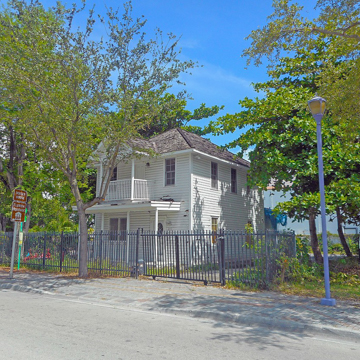The house of Dana Alfred Dorsey first appears on the 1914 plans of Miami. It is unknown exactly when or who built it, but since Dorsey was involved in real estate, it is likely that he expressed interest in its layout. Born in Quitman, Georgia, in 1872, Dorsey moved to Miami in 1896, the same year the city was incorporated. He began acquiring property in the downtown section set aside for black residents, called “Colored Town” or Overtown. Dorsey’s own Ninth Street residence was located near the center of a prominent civic and religious core of the segregated neighborhood. The two-story, hipped-roof house is three bays wide and rectangular in plan. It is clad in shiplap siding and painted white. An open porch runs the width of the main facade on the ground level, with a central, gable-roofed porch on the second story. The house originally fronted the sidewalk but was moved back fifty feet circa 1950 to accommodate a wider right-of-way.
Dorsey was one of the largest private black landowners in Miami. By 1911 he began appearing on rosters in the Miami Herald of proprietors who were levied fines by the city for property mismanagement. These infractions, however, seemed to have had little impact on Dorsey, who became a community leader who participated in the Civic Association, the Colored Odd Fellows, the Colored Chamber of Commerce, and the local school he helped to fund. Records indicate that he even paid the large sum of $1,500 in 1916 to repair the Baptist church just a block away from his residence.
Dorsey lived in this residence with his wife, Rebecca Livingston, until their deaths in 1940. Their daughter inherited the house. Overtown, which became known as a vibrant center for entertainment (attracting musicians like Cab Calloway and Nat King Cole, and literary artists such as Zora Neale Hurston), began to decline by the mid-1960s with the threat of urban renewal and the construction of two expressways that divided the neighborhood. Like much of the rest of Overtown, the Dorsey House fell into disrepair. In 1995 the house was acquired by the Black Archives History and Research Foundation of South Florida, a nonprofit organization founded in 1977 to preserve the heritage of the African American community in Miami-Dade County. As part of an effort to revitalize Overtown, the organization rehabilitated the historic Lyric Theater, which reopened in 2000. Since 2017, the Black Archives has begun fundraising to restore the Dorsey House and open it to the public as a museum.
References
“Dorsey Rites Set Tuesday: Negro was Influential with his Own Race.” The Miami Herald, March 2, 1940.
Eaton, Sarah, and Vicki L. Welcher, “D. A. Dorsey House,” Miami-Dade County, Florida. National Register of Historic Places Inventory–Nomination Form, 1989. National Park Service, U.S. Department of the Interior, Washington, D.C.
Metropolitan Dade County (Fla.). From Wilderness to Metropolis: The History and Architecture of Dade County, Florida, 1825-1940. Miami, FL: Metropolitan Dade County, 1982.
Nepomechie, Marilys. Building Paradise: An Architectural Guide to the Magic City. Miami, FL: AIA Miami, 2010.

